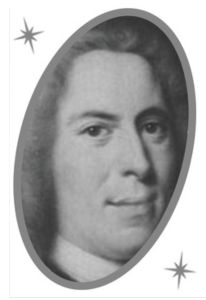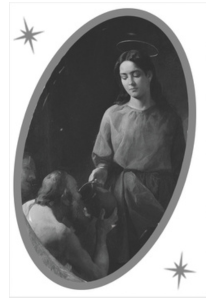It's the very last battle of the Round of 32! We'll be on to the Saintly Sixteen tomorrow. But today it's the last of the Zs as Nicolaus von Zinzendorf faces Zita of Tuscany.
Yesterday, Lucy Yi Zhenmei defeated Agatha Lin Zhao 63% to 37% to advance to the next round.
Check out your daily Lent Madness video here!
Vote now!
Nicolaus von Zinzendorf
 Joining other notable places like The Great Wall of China; the Cathedral of Notre-Dame and the Eiffel Tower; the Acropolis; the Virgin Mary’s House in Ephesus, Turkey; Stonehenge and Canterbury Cathedral; the Statue of Liberty; and the Grand Canyon, the Moravian Church Settlement Buildings in Bethlehem, Pennsylvania, were recently named a UNESCO World Heritage Site. This is thanks to Count Nicolaus von Zinzendorf.
Joining other notable places like The Great Wall of China; the Cathedral of Notre-Dame and the Eiffel Tower; the Acropolis; the Virgin Mary’s House in Ephesus, Turkey; Stonehenge and Canterbury Cathedral; the Statue of Liberty; and the Grand Canyon, the Moravian Church Settlement Buildings in Bethlehem, Pennsylvania, were recently named a UNESCO World Heritage Site. This is thanks to Count Nicolaus von Zinzendorf.
When the American author James Fenimore Cooper was researching Cultural details for his great novel, The Last of the Mohicans, he turned to the tomes amassed by the Moravians, based on their witness to Indigenous Natives. This is thanks to Zinzendorf. When the well-known prayer—Come, Lord Jesus, our Guest to be; And bless these gifts bestowed by Thee—is oft recited before meals, this is thanks to Zinzendorf. When visiting the celebrated Christmas City—Bethlehem, Pennsylvania—or Moravian University located there, this is thanks to Zinzendorf.
Count Nicolaus von Zinzendorf was a founder of the Moravian Church, which is in full communion with the Episcopal Church. He was born into a wealthy, titled family in Dresden, Germany, on May 26, 1700. After an extensive education that included law studies at the University of Wittenberg, he turned his back to privilege and embraced a life committed to Jesus.
Ordained in the Lutheran church, Zinzendorf irked many in 1727 when he offered outreach to religious exiles in Europe. He studied the writings of leading theologians and focused on the Moravian Church, Unitas Fratrum (United Brethren). His dedicated efforts and leadership sparked a renewal of that church. His contributions to Christ-like missionary efforts and Christian prayers and hymns cannot be understated. His outreach focused on slaves, Indigenous peoples, and German-speaking immigrants in this country.
While a missionary in the Caribbean in 1739, Zinzendorf traveled to the now–United States, where he became the only European nobleman known to expressly meet Indigenous chiefs.
In 1741, Zinzendorf visited Pennsylvania, arriving on Christmas Day on the shores of the Lehigh River. He then named the community, which remains a thriving area, “Bethlehem.”
Zinzendorf returned to Germany and died on May 9, 1760. At the time of his death, a remarkable 226 Moravian missionaries had been sent out, thanks to his lifelong efforts.
Collect for Nicolaus von Zinzendorf
God of new life in Christ: We remember the bold witness of your servant Nicolaus von Zinzendorf, through whom your Spirit moved to draw many to faith and conversion of life. We pray that we, like him, may rejoice to sing your praise; through Jesus Christ our Lord, who lives and reigns with you and the Holy Spirit, one God, now and for ever. Amen.
Zita of Tuscany
 If you have ever lost your keys, you may have prayed for intercession from St. Anthony, but devoted key-finders know that if you need a true expert, you call on Zita of Tuscany for help. Patron saint of maids and domestic servants, Zita was born in Florence to a poor family in 1212. She is remembered for her unflinching humility, generosity, and piety.
If you have ever lost your keys, you may have prayed for intercession from St. Anthony, but devoted key-finders know that if you need a true expert, you call on Zita of Tuscany for help. Patron saint of maids and domestic servants, Zita was born in Florence to a poor family in 1212. She is remembered for her unflinching humility, generosity, and piety.
Zita began working for the wealthy Fatinelli family when she was little more than a child. She dutifully fulfilled her tasks out of a sense of piety, not toward her employers, but toward God. Zita woke up hours earlier than others to attend daily mass, and saw her daily work as a penance and an act of service to God. Her pious and diligent attitude won her some popularity in the household, but as so often happens to earnest do gooders, also led to jealousy, cynicism, and derision. Other household members shunned her, even subjecting her to verbal abuse and beatings. No matter the circumstances, however, Zita’s diligence was unflagging. By remaining firmly rooted in her faith, she found the strength to endure.
Eventually, her hard work and patience were rewarded with a promotion. As housekeeper, she wielded her newfound power with Christ-like aplomb, and tales of her piety began to spread throughout the region. Zita remembered her roots in poverty and gave most of her money away, to the point of true sacrifice.
Zita of Tuscany is associated with many stories of generosity. When she traveled outside the estate to visit the sick and bring bread to the poor, she extended an offer of hospitality to any women in need of dinner and shelter.
Another story recounts a time when a servant reported her for stealing from the Fatinelli family to give their items to the poor. A family member tracked her down on one of her trips, and her apron was full of things to give away. Furious, the Fatinelli asked her what she was carrying; Zita dropped her apron, revealing nothing but fronds and flowers.
If you want to visit this remarkable thirteenth century woman, you are in luck. Zita is one of the “incorruptible” saints whose body is displayed in miraculously preserved condition. You can visit her at the Basilica of San Frediano in Lucca, Italy.
Collect for Zita of Tuscany
Merciful God, who has given to us all things necessary for life and godliness; Grant that we, like your servant Zita, may be faithful in the exercise of our duties and that, whatever you give us to do, we may do it heartily to you for the honor and glory of your Name; through him who has called us to virtue, Jesus Christ, your Son, our Lord. Amen.
63 comments on “Nicolaus von Zinzendorf vs. Zita of Tuscany”
Very much enjoyed learning about todays saintly match-up. Zita is a wonderful example, but Zinzendorf founded the Moravians and I lived 10 years in Winston-Salem NC, where the Moravians founded Salem. Many walks through Old Salem, Bethabara, and God's Acre in those years, with special memories of the outdoor Easter Sunrise Service with brass band.
I voted for Zita of Tuscany. She was know for her humility, generosity and piety. She cared for the poor.
Once,again I got yesterday's march up this morning!